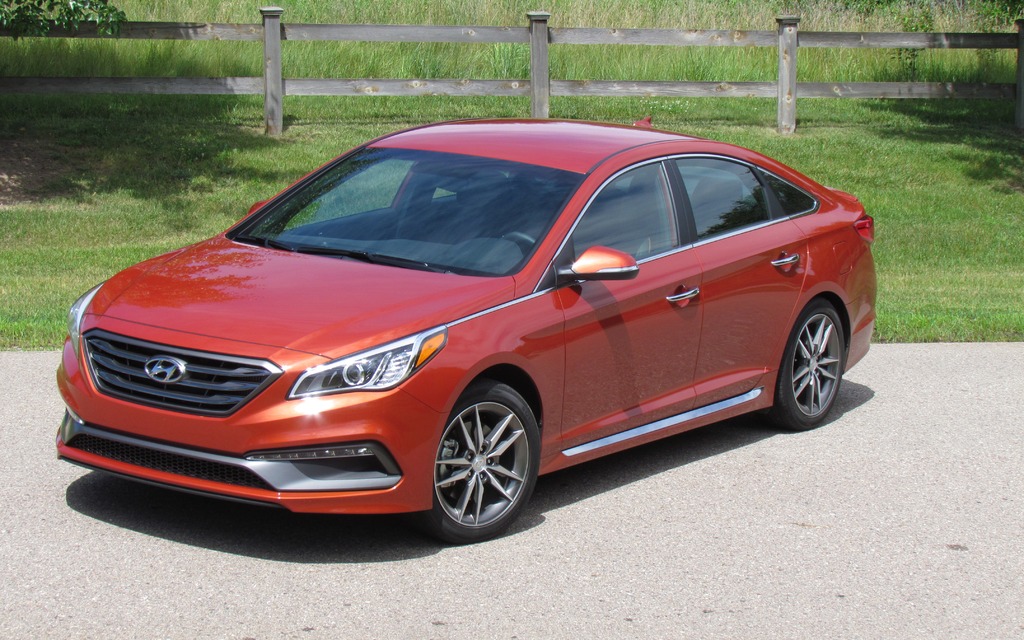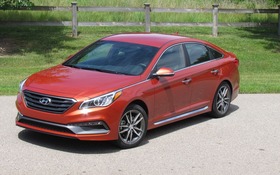2015 Hyundai Sonata: Refinement, Where it Counts

| Strong points |
|
|---|---|
| Weak points |
|
Midsize cars are second only to compact SUVs in sales in Canada, which would normally mean they sell quite well. But overall numbers are skewed by fleet sales, and demand for midsize sedans is actually dropping, as Canadian families are apparently finding compact SUVs to be more practical. Some manufacturers dedicate up to 85 percent of their midsize sedans to rental and corporate fleets, so that’s a lot of new cars that don’t actually make it into Canadian households. This could be a boon for a manufacturer, as fleet cars mostly end up in rental lots where customers essentially pay for what could potentially turn into a test drive.
According to Hyundai Canada’s product planning manager, Michael Ricciuto, fleet sales proved helpful for the current generation Sonata after rental customers, impressed with its performance, headed to dealers to plunk down cash on a purchase or lease. This probably accounts—at least partially—for why 68 percent of Hyundai buyers are new to the brand.
- Also: 2015 Hyundai Sonata : Things are getting serious
- Also: Bisimoto Is Back With Hyundai For The 2014 SEMA Show
Hyundai’s fleet sales are less than 15 percent in Canada, and the latest Sonata doesn’t need the extra help anyway because it was already a quiet and refined automobile, made only better after receiving several upgrades for 2015.
A redesigned exterior gives the new Sonata more fluid, modern lines and a sportier fascia, but the improvements go more than skin deep. There’s an increased use of high-strength steel and adhesives throughout the chassis, which has increased chassis rigidity significantly. This improves handling and safety, and contributes to a quieter ride without increasing weight.
The undercarriage has also been upgraded with revised suspension geometry and a new rear suspension that uses a dual lower arms, a change that improves high-speed stability.
Overall dimensions are slightly bigger, which has added a bit of interior volume. There’s 10mm more headroom for front passengers and 5mm for rear passengers, and rear passengers also benefit from an additional 25mm of legroom.
Hyundai has made significant improvements to the interior, and it shows. The centre stack is now in a horizontal layout, and there’s an available eight-inch touchscreen. Fit and finish seem to be above what you’d expect in this price range, though there’s still a bit of hard, textured plastic on the dashboard that brings the otherwise premium feel down a notch. There’s lots of room up front and in the rear, and the seats, although firm, are comfortable for long stretches.
Reworked Engines
The 2.4-litre four has had some internal changes that improve fuel economy. The variable valve timing system has gone from hydraulic actuation to electronic, which helps reduce emissions and improve fuel efficiency. The trade-off is a slight reduction in power to 185 hp from 190 hp. Torque is down just one foot-pound to 178 lb-ft, but it peaks a bit sooner so there’s a bit more grunt at lower speeds.
The 2.0-litre turbocharged four uses a smaller impeller, which reduces output but also reduces turbo lag and improves low-end torque. The turbo now makes 245 hp, a drop of 29 horsepower from the current 2.0L. Torque has dropped by 9 lb-ft to 260, but it peaks 300 rpm sooner.
Hyundai is among the first manufacturers to publish fuel consumption numbers using the new five-cycle test, and combined consumption for the 2.4-litre fuel is 8.4L/100 km, while the 2.0-litre turbo uses 9.1L/100 km.
Active Safety Features and Models Added
For 2015 Hyundai has added lane departure warning, forward collision warning, high beam assist, adaptive cruise control, blind spot warning, lane change assist and rear cross traffic alert to the list of available driver aids. There’s also a driver’s knee airbag now for added protection if all of the driver assists don’t help you avoid a collision.
There are also more trim levels available. Gone is the SE, but there’s now a selection of Sport models, available with either engine. In all there are seven variations, two more than the current Sonata.
The $23,999 GL is still the base model, and it’s relatively well appointed with standard air conditioning, heated front seats, Bluetooth, keyless entry and a variety of other convenient features. But if you want the added driver aids, like adaptive cruise, lane departure and forward collision warnings, you’ll have to opt for the $32,999 Limited or the top-of-the-line, $34,799 Ultimate model.
The Drive
The new Sonata is smooth and well-mannered, and the cabin is serene. I began with the Limited, with luxuries like the eight-inch screen with navi, and cooled front seats. The seat cooling works quite well, and you feel it almost immediately after turning it on. The 2.4L engine is adequate, nothing more, and runs smoothly when cruising. It labours when accelerating onto a highway or making a pass, though, and the six-speed transmission works smoothly but gear ratios are wide, so some engine noise makes it into the cockpit when you get hard on the gas.
There are three driving modes, Eco, Normal and Sport, each one altering transmission parameters and steering effort. They make a small difference, but I think the Sonata would do just fine if Sport mode were the only mode; the others just seem redundant.
The Sport 2.0T is more engaging to drive, with more power available throughout the rev range. It also has more direct steering response, and the suspension is firmer, though it exhibits a slightly choppy ride over highway expansion joints. My preference remains with the turbo model, as its power output is a better match for the Sonata’s size.
The Bottom Line
There’s no doubt that Hyundai can now be regarded as a maker of refined, reliable automobiles. Ricciuto had mentioned during a casual conversation that there is still a stigma surrounding Hyundai cars, and people still question their quality, reliability and performance. Well, Hyundai ranked fourth in J.D. Powers 2014 Initial Quality Study, behind Porsche, Jaguar and Lexus.
Even seasoned auto journalists, who once praised the brand for the improvements made to its products, are now beginning to nitpick on the finer details—an indication that things are mostly right. Add to that competitive pricing and above-class standard features, and you’ve got a potential category leader.
If these accolades aren’t enough to convince someone that Hyundai has upped its game, a drive in the new Sonata most certainly will.











